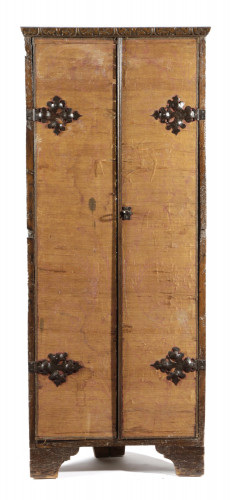Cabinet on Stand Dutch Renaissance Oak Ebonised Secret Locking Mechanism Key
11352
During the 17th century cabinets, along with a richly furnished bed, were the most important pieces of furniture in a Dutch home. This charming small cabinet would have either been placed in the Hall, which was the most important room in the house where the family took their meals and often housed the bed, to impress visitors or in the owner's bedchamber as a status symbol. The architectural design, ornamentation, ebonised inlay & applied split turnings, which contrast with the pale oak to add definition to the aesthetic, are characteristic features of Dutch furniture from this period. The oak has a Fine grain with a soft texture and beautiful medullary ray figuring which is also characteristic of Dutch furniture from this period. Its small size and secret locking mechanism suggest that it was used to protect it owners valuable objects being used as a cabinet of curiosity or documents or money. Dutch cabinet furniture from this period is typically large and it rare to find a piece with small proportions. This cabinet is a particularly Fine example of its type in exceptional condition with its original Stand. With the growing taste for imported Asian ceramics and their European imitations, cabinets were also used for a conspicuous display wealth with ceramic vessels arranged on top. Such an arrangements are depicted in Portrait of an Enkhuizen family c. 1635, anon., Enkhuizen, Zuiderzeemuseum; and Family at dinner table, attributed to Cornelis de Man, circa 1665-1670 in the collection of the J. Paul Getty Museum, Los Angeles.
The cabinet with a deep moulded cornice above a wide inlaid ebonized band in two sections. The double arcaded apron with a 'D' moulding below and an oak band with three small applied rectangular and two wooden discs. A pair of 5cm thick mitred doors below. The doors flanked with ebonized columnar pilasters with ionic capital headings. The deep moulded sections with geometric, ebonised inlaid ornament. The central pilaster with a lower sliding section revealing a keyhole, with a 19th century working lock behind. The interior retaining original hinges and catch and fitted with two oak shelves. A drawer below ornamented with three lion-mask corbels and rings, and a pair of panels with geometric ebonised ornament, the interior fitted with three compartments. The sides with vertical upper moulded panel above lower horizontal moulded panels with both with rectangular ebonised veneers. The back with an oak carcass in three sections
The stand with a deep moulded cornice above a wide inlaid ebonized band in two sections. The double arcaded apron with a 'D' moulding below and an oak band with three small applied rectangular and two wooden discs. A central small moulded panel below with ebonised inlaid centre and two similar panels at either end. The arches with inlaid ebonised geometric decoration and thick dentil carving on the inside edge. The four bulbous baluster turned legs with an inlaid ebonised central band and applied ebonised discs. The blocks with rectangular ebonised inlaid ornament and joined by an angled 'H' stretcher with geometric ebonised inlaid ornament. On original ball feet,
The sides with the same ornamentation as the front.
Overall height 175cm, cabinet height 77, stand height 98 cm Cornice depth 50cm stand depth 46.5cm Cornice width 92cm stand width 89cm
Provenance : Private Collection
Related: Cabinets depicted as status symbols in numerous mid-17th century Flemish & Dutch Old Master Paintings such as the larger cabinet in the background of Gabriel Metsu, The Hunter's Present c1658. Pieter de Hooch's painting, Interior with women beside a linen press, 1663, depicts a large kast from (or into) which a woman and a maid hand linen. An emblem in Jan Luiken, Het Leerzaam Huisraad Amsterdam, 1711 shows a mistress and maid at an open press stacked with neatly folded linens.
The Rijksmuseum in Amsterdam has a sidetable and drawleaf table with similar ornament. There are examples of this type of furniture in the collections of leading museums in the world.
17th Century
circa 1600-1620
Oak
Netherlands
Collectors
Renaissance (Of the period)
Joinery
GOOD. Wear consistent with age and use.
1

























